Set in late 1960s Chicago, My Favorite Thing Is Monsters by Emil Ferris is a gripping graphic diary of 10-year-old Karen Reyes, blending horror, pulp fiction, and self-discovery.
The Concept of “My Favorite Thing is Monsters”
My Favorite Thing Is Monsters is a graphic diary that explores the imaginative world of 10-year-old Karen Reyes. Set in late 1960s Chicago, it combines pulp horror aesthetics with a coming-of-age story, blending real-life political turmoil with fantastical monster imagery. The book captures Karen’s fascination with monsters as a metaphor for identity and resilience, creating a unique visual and narrative experience that transcends traditional storytelling.
Emil Ferris and Her Creative Vision
Emil Ferris’s debut, My Favorite Thing Is Monsters, showcases her inventive storytelling and artistry. Drawing from personal experiences and a love for pulp fiction, Ferris crafted a visual diary that blends fine art with pulp aesthetics. Her unique style, featuring intricate ballpoint pen illustrations, reflects Karen’s inner world, offering a fresh perspective on identity, trauma, and self-discovery through a child’s lens.
Plot Overview
Set in late 1960s Chicago, My Favorite Thing Is Monsters follows Karen Reyes, a 10-year-old girl, as she investigates the murder of her enigmatic neighbor, Anka Silverberg.
The Story of Karen Reyes
Karen Reyes, a 10-year-old girl in 1960s Chicago, narrates her life through a graphic diary filled with pulp fiction and horror imagery. She imagines herself as a wolfman detective, solving the murder of her neighbor, Anka Silverberg, while navigating her own identity and the turmoil around her, blending reality and fantasy in a unique visual style.
The Mystery of Anka Silverberg’s Murder
Anka Silverberg, a Holocaust survivor and Karen’s enigmatic neighbor, is found dead under mysterious circumstances. Karen, obsessed with solving the crime, intertwines reality with her pulp-inspired imagination, creating a unique narrative. The murder serves as a catalyst, revealing interconnected stories of those around her and deepening the mystery in 1960s Chicago’s turbulent backdrop.
Characters
Karen Reyes, a 10-year-old girl, narrates her journey through her graphic diary, while Anka Silverberg, her enigmatic neighbor, plays a central role in the unfolding mystery.
Karen Reyes: The Protagonist
Karen Reyes, the 10-year-old protagonist, is a curious girl living in 1960s Chicago. She loves pulp fiction monsters and imagines herself as a wolfman detective. Determined and fiercely independent, Karen documents her life in a graphic diary, blending her fantasies with the harsh realities of her neighborhood. Her journey is one of self-discovery and resilience.
Anka Silverberg: The Enigmatic Neighbor
Anka Silverberg, Karen’s upstairs neighbor, is a Holocaust survivor whose mysterious past intrigues Karen. Her death sets off a chain of events, with Karen determined to uncover the truth. Anka’s enigmatic presence and complex history serve as a catalyst for Karen’s detective work, intertwining their stories in unexpected ways. Her life and death remain central to the plot.

Themes and Symbolism
The graphic novel explores themes of identity, self-discovery, and social commentary, blending horror and pulp fiction aesthetics to reflect Karen’s inner world and the turmoil of 1960s Chicago.
Horror and Pulp Fiction Influences
The graphic diary is rich with B-movie horror and pulp monster imagery, reflecting Karen’s fascination with the genre. Monsters serve as metaphors for real-life fears, blending the fantastical with the dark realities of her world. This fusion of horror aesthetics and personal narrative creates a unique visual and storytelling style, deeply rooted in pulp culture.
Identity and Self-Discovery
Karen Reyes’ journey is a poignant exploration of identity, as she navigates childhood, sexuality, and belonging. Through her graphic diary, she expresses her inner world, identifying with monsters as symbols of her outsider status. The late ’60s Chicago setting amplifies her struggles with societal expectations, making her self-discovery a powerful metaphor for resilience and understanding.
Social and Political Commentary
Set against the backdrop of late ’60s Chicago, the graphic diary reflects the era’s political turmoil and social unrest. Through Karen’s lens, the novel critiques racial, gender, and class disparities, while the Holocaust survivor Anka Silverberg’s story adds historical depth. The blend of pulp aesthetics and personal narrative underscores themes of marginalization and resilience, offering a powerful commentary on identity and societal norms.
Artwork and Style
My Favorite Thing Is Monsters features a unique blend of fine art and pulp aesthetics, with intricate ballpoint pen collages. The notebook-style design immerses readers in Karen’s diary, creating a haunting yet intimate visual experience that reflects her inner world and the monsters she adores.
Visual Narrative and Graphic Diary Format
Emil Ferris employs a graphic diary format, presenting Karen’s story through handwritten notes and sketches. The visual narrative captures her imagination, blending pulp horror imagery with personal reflections. This intimate format creates a sense of authenticity, drawing readers into Karen’s world and her unique perspective on the events unfolding around her.
Blend of Fine Art and Pulp Aesthetics
Ferris’s artwork combines fine art techniques with pulp-inspired visuals, creating a unique aesthetic. The illustrations, often described as sweaty caricatures and ballpoint collages, reflect Karen’s inner world, merging high and low art forms seamlessly. This blend captivates readers, offering both a visually striking and emotionally resonant experience that mirrors the protagonist’s complex identity.

Historical Context
Set against the backdrop of late 1960s Chicago, the story unfolds amidst political turmoil and social change, influencing Karen’s experiences and perceptions as reflected in her diary.
Late 1960s Chicago as a Setting
The story is set in late 1960s Chicago, a city simmering with political unrest and social upheaval. The backdrop of racial tensions, protests, and cultural shifts deeply influences Karen’s narrative, as she navigates her neighborhood and the mysteries surrounding Anka Silverberg’s death. The setting’s turmoil mirrors the chaos of Karen’s inner world, creating a rich, immersive atmosphere.
Political Turmoil and Social Change
Set against the backdrop of late 1960s Chicago, the graphic novel captures the era’s political unrest and social upheaval. The city’s racial tensions, protests, and cultural shifts provide a volatile setting that mirrors Karen’s journey. The narrative weaves historical context with personal struggle, reflecting the broader societal changes through Karen’s unique perspective and experiences.

Reception and Reviews
My Favorite Thing Is Monsters received widespread critical acclaim for its unique storytelling, artwork, and emotional depth. It has won several prestigious awards and remains a reader favorite.
Critical Acclaim and Awards
Emil Ferris’s My Favorite Thing Is Monsters garnered widespread critical acclaim, earning numerous awards for its innovative storytelling and artistry. The graphic novel was praised for its unique blend of pulp fiction and fine art, solidifying its place as a landmark in the graphic novel genre. Its success also sparked a competitive bidding war for screen rights, further cementing its cultural impact.
Reader Responses and Popularity
Readers praised My Favorite Thing Is Monsters for its unique narrative and vivid artwork. The graphic diary format resonated deeply, with many appreciating its raw, emotional depth. The book’s popularity soared, driven by its accessibility in PDF and print formats. Fans lauded Karen’s relatable journey, making it a beloved and widely shared graphic novel across various platforms.

Cultural Impact
My Favorite Thing Is Monsters has significantly influenced graphic novels, inspiring creators with its unique blend of art and storytelling. Its adaptation into film, secured by Sony, further amplifies its cultural resonance, solidifying its place as a groundbreaking work in both literary and visual media.
Influence on Graphic Novels
My Favorite Thing Is Monsters has redefined the graphic novel medium, inspiring creators with its innovative storytelling and artistic fusion of pulp aesthetics with fine art. Emil Ferris’s work has set a new standard, encouraging experimentation in visual narratives and genre blending, making it a pivotal influence in contemporary graphic literature.
Adaptation and Media Interest
My Favorite Thing Is Monsters has garnered significant media attention, with Sony acquiring screen rights after a competitive studio bidding war. The graphic novel’s unique blend of horror, mystery, and coming-of-age themes has captivated filmmakers, highlighting its potential for cinematic adaptation. This high-profile interest underscores the book’s cultural resonance and Emil Ferris’s visionary storytelling.
Availability and Access
My Favorite Thing Is Monsters is available as a PDF download and in digital formats. Print editions are also collectible, ensuring wide accessibility for readers.
PDF and Digital Formats
My Favorite Thing Is Monsters is widely available in digital formats, including PDF, EPUB, and Kindle. The book can be downloaded for free or purchased online, offering readers convenient access to Emil Ferris’s acclaimed graphic novel. Its digital versions maintain the original artwork’s quality, ensuring an immersive reading experience for fans worldwide.
Print Editions and Collectibility
The print edition of My Favorite Thing Is Monsters is published by Fantagraphics, offering a high-quality, 416-page hardcopy. Its unique design and artwork make it a sought-after collectible, especially among graphic novel enthusiasts; The book’s cultural impact and critical acclaim have further increased its value, making it a treasured addition to any collection of contemporary comics and illustrated literature.
My Favorite Thing Is Monsters leaves a lasting legacy as a groundbreaking graphic novel, celebrated for its unique storytelling and artwork. Emil Ferris’s debut has earned critical acclaim and a devoted following, with anticipation growing for Volume 2 to continue Karen Reyes’s compelling journey.
The Legacy of “My Favorite Thing is Monsters”
My Favorite Thing Is Monsters has left an indelible mark on the graphic novel genre, earning widespread critical acclaim and inspiring a devoted following. Emil Ferris’s debut has been celebrated for its unique storytelling, blending pulp horror with poignant self-discovery. The book’s success has solidified its place as a modern classic, influencing future graphic novels and cementing Ferris as a major talent in the medium.
Future Prospects and Volume 2
My Favorite Thing Is Monsters continues to captivate audiences, with Volume 2 highly anticipated. Emil Ferris’s groundbreaking work has sparked excitement for its conclusion, promising deeper exploration of Karen’s journey and the mysteries surrounding her. The series’ cultural impact ensures its influence will grow, with fans eagerly awaiting new developments and potential adaptations, solidifying its place in graphic novel history.
